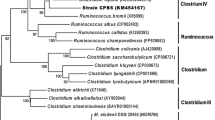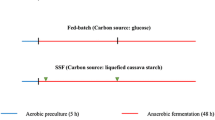Abstract
Lactate-utilizing bacteria play important roles in the production of Chinese strong-flavored liquor (CSFL). However, the identity of these bacteria and their lactate-utilizing properties are largely unknown. Here, a lactate-utilizing, butyrate-producing bacterium BPY5 was isolated from an old fermentation pit for CSFL production. The isolate represented a novel species belonging to Clostridium cluster XIVa of family Lachnospiraceae based on phylogenetic analysis using 16S rRNA gene sequences. Strain BPY5 could ferment lactate into butyrate as the major metabolic product. Butyrate was significantly formed at initial lactate concentration from 66 to 104 mM, but substantially declined when initial lactate exceeded 133 mM. At initial lactate concentration of 66 mM, lactate conversion was independent on initial pH from 5.5 to 7.0, but the conversion was completely inhibited when pH dropped below 4.8. Nevertheless, the inhibition on lactate conversion was largely relieved by the addition of acetate, suggesting that exogenous acetate could enhance lactate conversion at low pH condition. Additionally, lactate in CSFL-brewing wastewater was dramatically removed when inoculated with strain BPY5. These results implicate that the isolate may be applied for the industrial production of butyrate or the recovery of butyrate from lactate-containing wastewater.






Similar content being viewed by others
Abbreviations
- CSFL:
-
Chinese strong-flavored liquor
- CSFL-BW:
-
CSFL-brewing wastewater
References
Zhen, D., Guo, Y. S., & Chen, M. L. (2009). Separation & identification of lactate-utilizing bacteria in Luzhou-flavor liquor production and study of its properties. Liquor-making Science & Technology, 8, 52–54 (in chinese).
Zhen, D., Yao, W. Q., & Chen, M. B. (2009). Environmental tolerance of lactate-utilizing bacteria and their effects on stimulated solid fermentation of Luzhou-flavor liquor. Liquor-making Science & Technology, 183, 38–40 (in chinese).
Tao, Y., Li, J. B., Rui, J. P., Xu, Z. C., Zhou, Y., Hu, X. H., Wang, X., Liu, M. H., Li, D. P., & Li, X. Z. (2014). Prokaryotic communities in pit mud from different-aged cellars used for the production of Chinese strong-flavored liquor. Applied and Environmental Microbiology, 80, 2254–2260.
Li, X. R., Ma, E. B., Yan, L. Z., Meng, H., Du, X. W., Zhang, S. W., & Quan, Z. X. (2011). Bacterial and fungal diversity in the traditional Chinese liquor fermentation process. International Journal of Food Microbiology, 146, 31–37.
Padan, E., Zilberstein, D., & Schuldiner, S. (1981). Ph homeostasis in bacteria. Biochimica et Biophysica Acta, 650, 151–166.
Belenguer, A., Duncan, S. H., Holtrop, G., Anderson, S. E., Lobley, G. E., & Flint, H. J. (2007). Impact of pH on lactate formation and utilization by human fecal microbial communities. Applied and Environmental Microbiology, 73, 6526–6533.
Duncan, S. H., Louis, P., & Flint, H. J. (2004). Lactate-utilizing bacteria, isolated from human feces, that produce butyrate as a major fermentation product. Applied and Environmental Microbiology, 70, 5810–5817.
Weimer, P. J., & Moen, G. N. (2013). Quantitative analysis of growth and volatile fatty acid production by the anaerobic ruminal bacterium Megasphaera elsdenii T81. Applied Microbiology Biotechnology, 97, 4075–4081.
Prabhu, R., Altman, E., & Eiteman, M. A. (2012). Lactate and acrylate metabolism by Megasphaera elsdenii under batch and steady-state conditions. Applied and Environmental Microbiology, 78, 8564–8570.
Whanger, P. D., & Matrone, G. (1967). Metabolism of lactic succinic and acrylic acids by rumen microorganisms from sheep fed sulfur-adequate and sulfur-deficient diets. Biochimica et Biophysica Acta, 136(1), 27–35.
Duncan, S. H., Barcenilla, A., Stewart, C. S., Pryde, S. E., & Flint, H. J. (2002). Acetate utilization and butyryl coenzyme A (CoA): acetate-CoA transferase in butyrate-producing bacteria from the human large intestine. Applied and Environmental Microbiology, 68, 5186–5190.
Saint-Amans, S., Girbal, L., Andrade, J., Ahrens, K., & Soucaille, P. (2001). Regulation of carbon and electron flow in Clostridium butyricum VPI 3266 grown on glucose-glycerol mixtures. Journal of Bacteriology, 183, 1748–1754.
Bennett, G. N., & Rudolph, F. B. (1995). The central metabolic pathway from acetyl-Coa to butyryl-Coa in Clostridium-acetobutylicum. Feminist Microbiology Review, 17, 241–249.
Vital, M., Howe, A. C. and Tiedje, J. M. (2014) Revealing the Bacterial Butyrate Synthesis Pathways by Analyzing (Meta) genomic Data. Mbio,s 5. ( http://mbio.asm.org/content/5/2/e00889-14.full.pdf)
Bourriaud, C., Robins, R. J., Martin, L., Kozlowski, F., Tenailleau, E., Cherbut, C., & Michel, C. (2005). Lactate is mainly fermented to butyrate by human intestinal microfloras but inter-individual variation is evident. Journal of Applied Microbiology, 99, 201–212.
Newbold, C. J., Williams, A. G., & Chamberlain, D. G. (1987). The in vitro metabolism of D, L-lactic acid by rumen microorganisms. Journal of the Science of Food and Agriculture, 38, 9–18.
Ze, X. L., Duncan, S. H., Louis, P., & Flint, H. J. (2012). Ruminococcus bromii is a keystone species for the degradation of resistant starch in the human colon. The Isme Journal, 6, 1535–1543.
Schut, G. J., Bridger, S. L., & Adams, M. W. W. (2007). Insights into the metabolism of elemental sulfur by the hyperthermophilic archaeon Pyrococcus furiosus: characterization of a coenzyme A-dependent NAD(P)H sulfur oxidoreductase. Journal of Bacteriology, 189, 4431–4441.
Lee, H. S., & Rittmann, B. E. (2009). Evaluation of metabolism using stoichiometry in fermentative biohydrogen. Biotechnology and Bioengineering, 102, 749–758.
Grootscholten, T. I. M., Strik, D. P. B. T. B., Steinbusch, K. J. J., Buisman, C. J. N., & Hamelers, H. V. M. (2014). Two-stage medium chain fatty acid (MCFA) production from municipal solid waste and ethanol. Applied Energy, 116, 223–229.
Diezgonzalez, F., Russell, J. B., & Hunter, J. B. (1995). The role of an Nad-independent lactate-dehydrogenase and acetate in the utilization of lactate by Clostridium-acetobutylicum strain P262. Archives of Microbiology, 164, 36–42.
Hashsham, S. A., Fernandez, A. S., Dollhopf, S. L., Dazzo, F. B., Hickey, R. F., Tiedje, J. M., & Criddle, C. S. (2000). Parallel processing of substrate correlates with greater functional stability in methanogenic bioreactor communities perturbed by glucose. Applied and Environmental Microbiology, 66, 4050–4057.
Matsumoto, M., & Nishimura, Y. (2007). Hydrogen production by fermentation using acetic acid and lactic acid. Journal of Bioscience and Bioengineering, 103, 236–241.
Wu, C. W., Whang, L. M., Cheng, H. H., & Chan, K. C. (2012). Fermentative biohydrogen production from lactate and acetate. Bioresource Technology, 113, 30–36.
Collins, M. D., Lawson, P. A., Willems, A., Cordoba, J. J., Fernandezgarayzabal, J., Garcia, P., Cai, J., Hippe, H., & Farrow, J. A. E. (1994). The phylogeny of the genus Clostridium—proposal of 5 new genera and 11 new species combinations. International Journal of Systematic Bacteriology, 44, 812–826.
Munoz-Tamayo, R., Laroche, B., Walter, E., Dore, J., Duncan, S. H., Flint, H. J., & Leclerc, M. (2011). Kinetic modelling of lactate utilization and butyrate production by key human colonic bacterial species. Feminist Microbiology Ecology, 76, 615–624.
Duncan, S. H., Belenguer, A., Holtrop, G., Johnstone, A. M., Flint, H. J., & Lobley, G. E. (2007). Reduced dietary intake of carbohydrates by obese subjects results in decreased concentrations of butyrate and butyrate-producing bacteria in feces. Applied and Environmental Microbiology, 73, 1073–1078.
Sato, T., Matsumoto, K., Okumura, T., Yokoi, W., Naito, E., Yoshida, Y., Nomoto, K., Ito, M., & Sawada, H. (2008). Isolation of lactate-utilizing butyrate-producing bacteria from human feces and in vivo administration of Anaerostipes caccae strain L2 and galacto-oligosaccharides in a rat model. Feminist Microbiology Ecology, 66, 528–536.
Presser, K. A., Ratkowsky, D. A., & Ross, T. (1997). Modelling the growth rate of Escherichia coli as a function of pH and lactic acid concentration. Applied and Environmental Microbiology, 63, 2355–2360.
Thylin, I., Schuisky, P., Lindgren, S., & Gottschal, J. C. (1995). Influence of Ph and lactic-acid concentration on Clostridium-tyrobutyricum during continuous growth in a Ph-auxostat. The Journal of Applied Bacteriology, 79, 663–670.
Van Ginkel, S., & Logan, B. E. (2005). Inhibition of biohydrogen production by undissociated acetic and butyric acids. Environmental Science and Technology, 39, 9351–9356.
Canganella, F., Kuk, S. U., Morgan, H., & Wiegel, J. (2002). Clostridium thermobutyricum: growth studies and stimulation of butyrate formation by acetate supplementation. Microbiology Research, 157, 149–156.
Gottschal, J. C., & Morris, J. G. (1981). The induction of acetone and butanol production in cultures of Clostridium-acetobutylicum by elevated concentrations of acetate and butyrate. Feminist Microbiology Letter, 12, 385–389.
Holt, R. A., Stephens, G. M., & Morris, J. G. (1984). Production of solvents by Clostridium-acetobutylicum cultures maintained at neutral Ph. Applied and Environmental Microbiology, 48, 1166–1170.
Husemann, M. H. W., & Papoutsakis, E. T. (1990). Effects of propionate and acetate additions on solvent production in batch cultures of Clostridium-acetobutylicum. Applied and Environmental Microbiology, 56, 1497–1500.
Chen, C. K., & Blaschek, H. P. (1999). Effect of acetate on molecular and physiological aspects of Clostridium beijerinckii NCIMB 8052 solvent production and strain degeneration. Applied and Environmental Microbiology, 65, 499–505.
Walker, A. W., Duncan, S. H., Leitch, E. C. M., Child, M. W., & Flint, H. J. (2005). pH and peptide supply can radically alter bacterial populations and short-chain fatty acid ratios within microbial communities from the human colon. Applied and Environmental Microbiology, 71, 3692–3700.
Zhu, Y., & Yang, S. T. (2004). Effect of pH on metabolic pathway shift in fermentation of xylose by Clostridium tyrobutyricum. Journal of Biotechnology, 110, 143–157.
Isken, S., & de Bont, J. A. M. (1998). Bacteria tolerant to organic solvents. Extremophiles, 2, 229–238.
Acknowledgments
This research was sponsored by the National Natural Science Foundation of China (nos. 31270531 and 3470020), the Open-foundation project of Key Laboratory of Environmental and Applied Microbiology, Chinese Academy of Sciences (no. KLCAS-2013-03), and the 973 Project of China (no. 2013CB733502).
Author information
Authors and Affiliations
Corresponding authors
Ethics declarations
It is the original work of the authors. The work described here has not been submitted elsewhere for publication, in whole or in part, and all authors listed carry out the data analysis and manuscript writing, and this article does not contain any studies with human participants or animals performed by any of the authors. Moreover, all authors read and approved the final manuscript.
Conflict of Interest
The authors declare that they have no direct or indirect conflict of interest.
Electronic Supplementary Material
Below is the link to the electronic supplementary material.
ESM. 1
(DOCX 131 kb)
Rights and permissions
About this article
Cite this article
Tao, Y., Hu, X., Zhu, X. et al. Production of Butyrate from Lactate by a Newly Isolated Clostridium sp. BPY5. Appl Biochem Biotechnol 179, 361–374 (2016). https://doi.org/10.1007/s12010-016-1999-6
Received:
Accepted:
Published:
Issue Date:
DOI: https://doi.org/10.1007/s12010-016-1999-6




